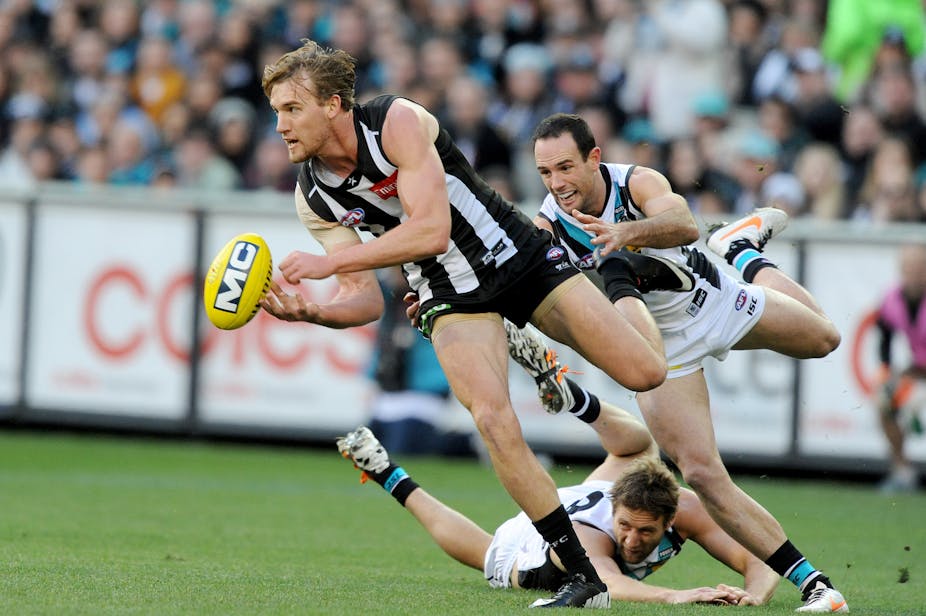Ten years ago, the AFL introduced its policy on “out of competition” illicit drug use. It was the first Australian sport to do so, and was prompted by the AFL’s awareness that some of its players were marijuana users. The AFL worried that players who used cannabis risked testing positive “in competition”. Under the World Anti-Doping Agency (WADA) Code, if traces of cannabis – or other illicit substances – showed up during “in competition” testing, there is the prospect of significant penalties.
Now, the AFL is mortified by something different – inadvertent doping by players who have used illicit drugs that have been cut with a performance-enhancing substance.
In March, it was announced that two players from the Collingwood Football Club, Lachlan Keeffe and Josh Thomas, have tested positive to clenbuterol, a banned performance-enhancing drug that is known to be used to cut cocaine. The results of the players’ “B samples” are pending. But they are under WADA scrutiny at a time when the 2015 code, which enforces penalties of up to four years for doping, is in operation.
AFL players have voluntarily agreed to the league’s illicit drugs policy because the primary focus of a positive test is remediation under medical supervision, not naming and shaming. Players receive confidential drug counselling and face target testing with the first two “strikes”, followed by a A$5000 fine and suspension (12-18 weeks) in the case of a third positive.
Without making assumptions about the Keeffe-Thomas case, there may be career-ending sanctions for players who have inadvertently tested positive to a performance-enhancing drug after having consumed an illicit drug. This has led to strong calls for reform of the AFL’s illicit drugs policy.
Contradictory messages
Although players using marijuana or ecstasy hardly do so for performance enhancement, WADA has long viewed these substances as a form of doping – and by extension cheating – when found in the body on match day.
This position is complicated by WADA not requiring, nor taking responsibility, for the testing of illicit drugs out of competition. If that testing happens at all, it is up to individual sports (and their budgets), and is independent of WADA and its code.
I have argued previously that the AFL, like other leading sport organisations, has five key aspirations with its illicit drug policy. These can be summarised as the management of risk, reputation and welfare – whether to players or the sport.
There has been robust support and criticism of the AFL’s illicit drug policy for many years. And now, this debate has reached a crescendo.
Medical or punitive model?
Critics – including some AFL coaches – contend that the current three strikes system “hides” problematic players. Although a club’s medical officer is informed of a strike, that information remains in confidence.
Consequently, it is asserted, the strike fails to either deter the individual or enable the coach and club to proactively assist them. Players are said to be able to run the gauntlet of illicit drug use without fear of repercussions until a third indiscretion.
Sceptics also lament that footballers are allowed to “self-report” illicit drug use on one occasion – thus avoiding a strike.
The most severe critics argue that illicit drug policy should be like that of WADA for performance-enhancing drugs: zero tolerance, public identification and substantial penalties – even banishment at the first positive test. That is surveillance for the purpose of punishment, as opposed to detection in the interests of remediation.
The way forward
My sense is that the AFL Players Association – the players’ union – will stand firm about a medical model of treatment and player privacy. But there may be room for negotiation in terms of:
the number of strikes;
suspensions at each strike (as in England’s Football Association); and
confidential briefings to a club’s coach and CEO, together with its doctor.
This is something of a “middle way” between those who advocate the status quo and those who seek a hardline approach.
If recent media comments are any guide, the players themselves are not opposed to a more substantive testing regime.
There are calls to increase analyses of hair samples, which can diagnose illicit drug use over the past three months. However, there would need to be a change of process. Hair samples have thus far been used to provide statistical information about collective use. The much less effective two-to-three-day window urinalysis is the official method for testing individuals.
There is no appetite among players to be publicly named. But should suspensions be introduced at each strike, the logistics of explaining a player absence – such as a fake injury – could prove challenging, as has been found in English Premier League football.
A more proactive approach is now needed given the ongoing risk of testing positive to an illicit drug in competition, and a growing realisation that illicit drug use out of competition may put players at risk of inadvertent doping. It is therefore much more than a health and welfare issue: it is also about risk management.
Players can take the lead – should they choose to – in helping to protect their colleagues from harm on several fronts.

